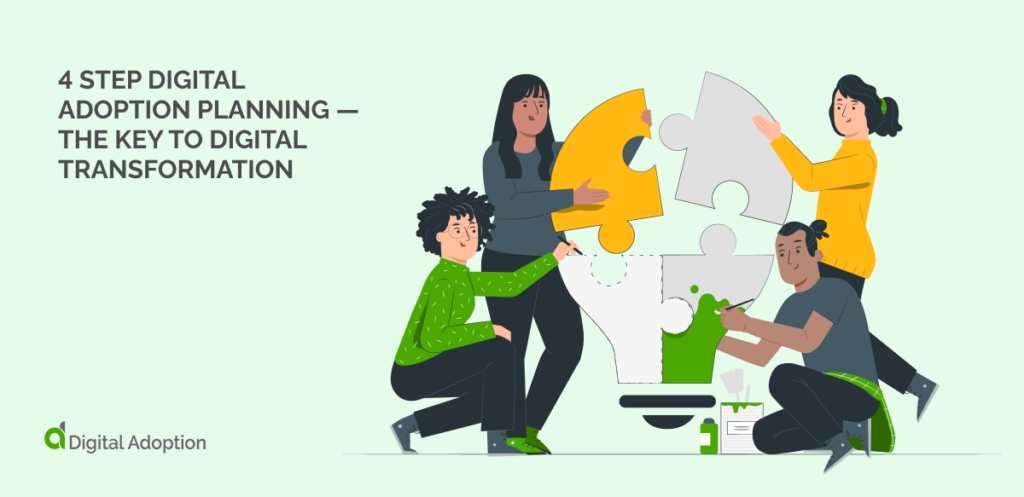Before embarking on your digital transformation journey, you need a comprehensive plan. It’s tempting to jump into technology investments and hope for the best. Without a thorough plan, your digital adoption will be susceptible to disruptions (of the negative kind).
Consider this your comprehensive guide to digital adoption planning. We’ll explain the four steps of a successful transformation plan and explore how to minimize employee resistance.
The State of Digital Transformation
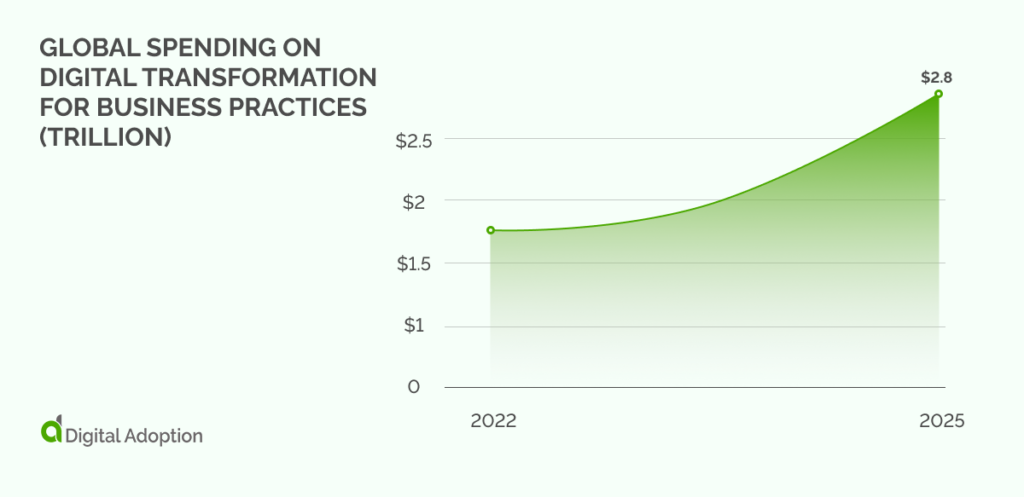
According to IDC, ‘global spending on digital transformation for business practices […] and organizations is forecast to reach $2.8 trillion in 2025.’ Business leaders understand the transformational power of digital tools, but are they utilizing their investments wisely?
Today, 34% of organizations say they have the proper leadership in place to implement a digital transformation strategy, compared to 49% in 2012.
Companies are struggling to keep up with the progression of digital technology. This problem will only get worse as the digital revolution grows. In today’s digital age, the average customer is more tech-savvy and they expect companies to offer services that meet their evolving demands.
Business leaders make the mistake of investing in more technology in the hope that digital transformation will happen miraculously. They fail to get the most out of new technology because they lack cohesive digital transformation strategies. An integral part of digital transformation is planning. But how do you plan for maximum success?
4 Digital Adoption Planning Must-haves
We’ve broken down four key elements of the planning process used by leading digital transformation experts across various industries. These adoption must-haves will take your transformation plan to the next level.
1. An Understanding of True Digital Adoption
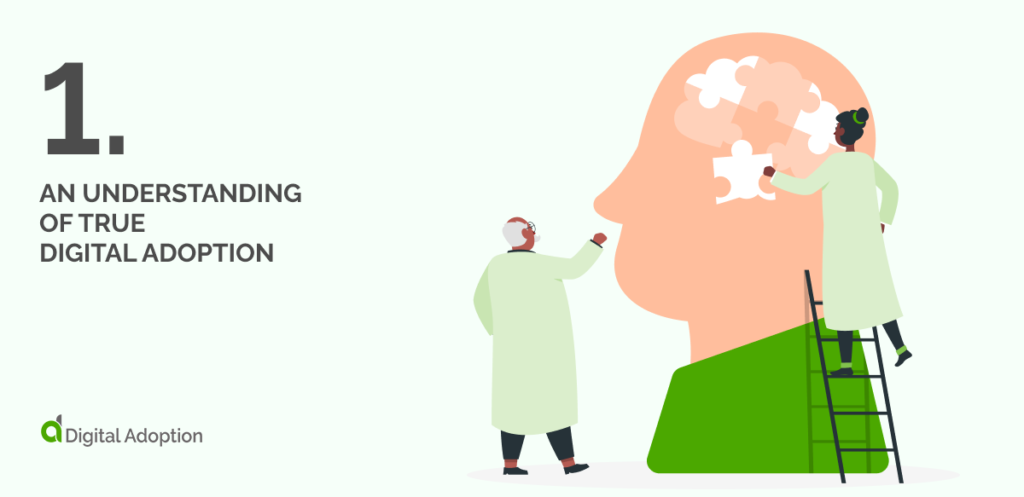
Before implementing a comprehensive digital adoption strategy, you must understand its meaning.
Digital adoption is a component of digital transformation. Many think of it as the human side of technology integration. Companies integrate digital technology to grow their business. This could mean enhancing workflow, improving organizational processes, or boosting employee productivity.
Digital adoption focuses on the best way to integrate the efficiency of new digital tools. An adoption strategy targets users of digital tools to minimize resistance. This means helping employees and stakeholders adapt to unfamiliar software. You achieve this through training, communication, and incentivization.
It all comes down to knowing how to get the most out of your technology investments. For example, let’s say your favorite coffee shop releases a new app–customers can now order for delivery, check the menu in advance, and collect rewards. On the surface, it looks like a worthwhile investment for the company. But the business isn’t using the full potential of the tool.
They miss the opportunity to gain customer insights through increased data analytics. They fail to offer a better service because they aren’t leveraging their true data analysis capabilities. The problem is that similar companies with a better understanding of true digital adoption will not make the same mistakes.
2. Good Digital Onboarding
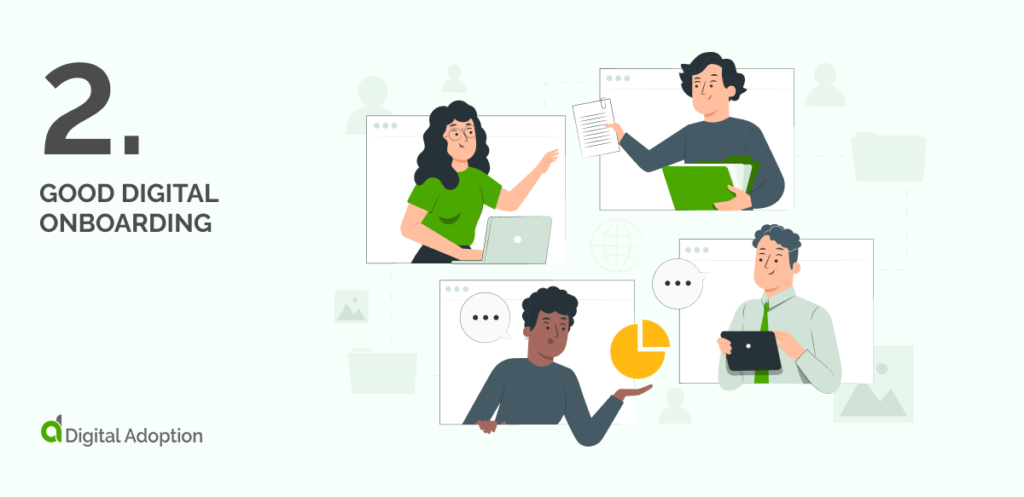
As mentioned before, digital adoption focuses on the human side of technology integration. Users of technology are the biggest obstacle to a successful adoption strategy. Training is the only way to ensure full engagement with digital initiatives in the workplace.
This is a two-part process. Onboarding current employees to new technologies and introducing new hires to existing technologies. Streamlining this process is crucial.
Companies need to plan how they’ll train employees on new technologies. Expecting employees to adapt straight away is a recipe for disaster. You’ll further frustrate employees and make the adoption of new tools in the future more difficult.
So, how do you create an effective training plan?
First, consider the level of training you need. Are you overhauling the current digital systems that employees use? Or are you introducing new tools that you want employees to learn? Once you answer these questions, you can plan around the requirements of employees.
A great tool to improve your training efforts is a digital adoption platform (DAPS). Digital adoption platforms are software that integrates with a new digital tool. They help to streamline the learning process.
DAPs are flexible tools that help guide users through key tasks. They customize training based on the needs of each user, decreasing the resistance to digital technologies.
During the training process, you need a way to monitor progress. Knowing what works and what doesn’t will determine the success of the training. Digital adoption platforms look out for weak areas during training. They feed information back to leaders who can make adjustments to training.
Remember, communication is crucial to guiding employees through the digital transformation process. Make sure they feel supported. Reassure your workforce that new technology will make their work more rewarding.
3. A Clear Digital Adoption Plan
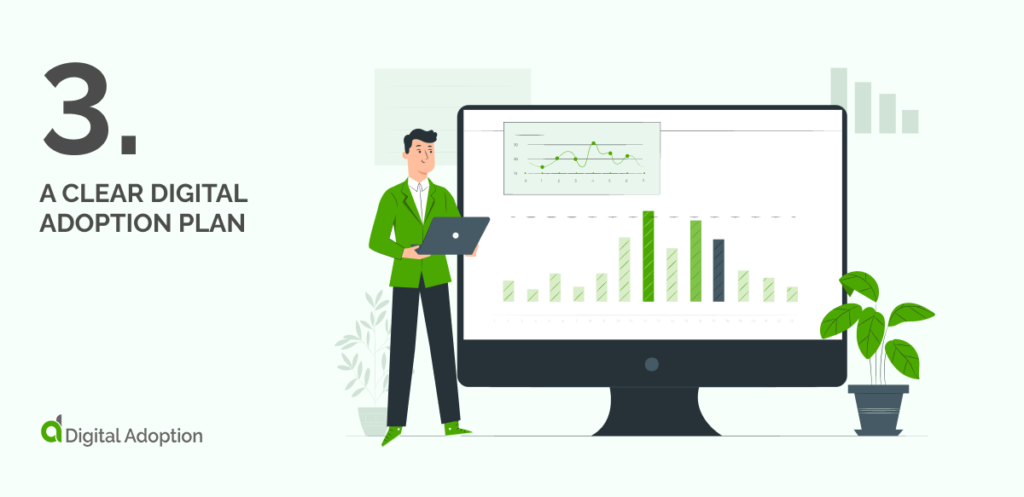
The key to a successful digital transformation strategy is precision. A cohesive and user-focused plan will receive more support from stakeholders.
Your digital transformation strategy should outline how you’ll achieve company goals. For example, let’s say you aim to improve the recruitment process. You should communicate your goals to the recruitment team. Show them how you’ll install digital technology to enhance their work. Make sure to support the team throughout the learning process.
Employees will have more confidence in a concise and well-executed plan.
4. No Cultural Barriers
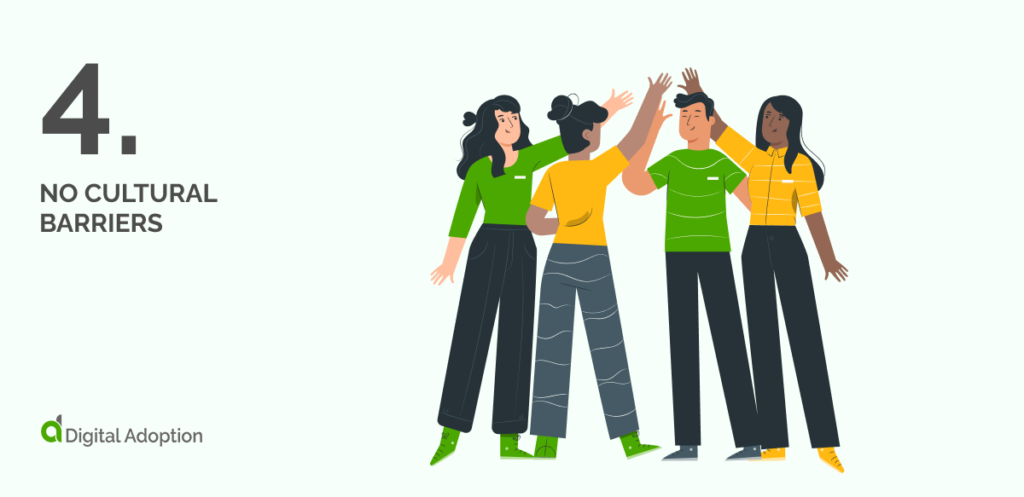
Consider how your strategy will affect employees and stakeholders during the planning stage. Users determine the success of the digital transformation process. Focus on breaking down the common barriers to accepting emerging technology.
Fear of the Unfamiliar
Digital technology represents a new way of doing things. Employees like to stick to what they know, which can be a problem when trying to innovate. Remind workers that tradition isn’t always the best. Digital technology exists to improve functions, workflow, and efficiency.
Lack of Change Management
Change management is the process of supporting a workforce through change initiatives. Learning new technology isn’t always easy. Employees become more resistant to change if they don’t receive adequate support.
Management should listen to the needs of employees and make necessary changes to the process. This could mean a customized approach to training. It can also mean being transparent about the goals of the adoption strategy.
Concerns About Employee Redundancy
The future of robots displacing the human workforce isn’t yet in sight. Even so, workers fear change because they fear redundancy. Leaders should reassure employees that digital technology is there to help, not replace them.
Preparing Your Workforce To Adopt New Technology
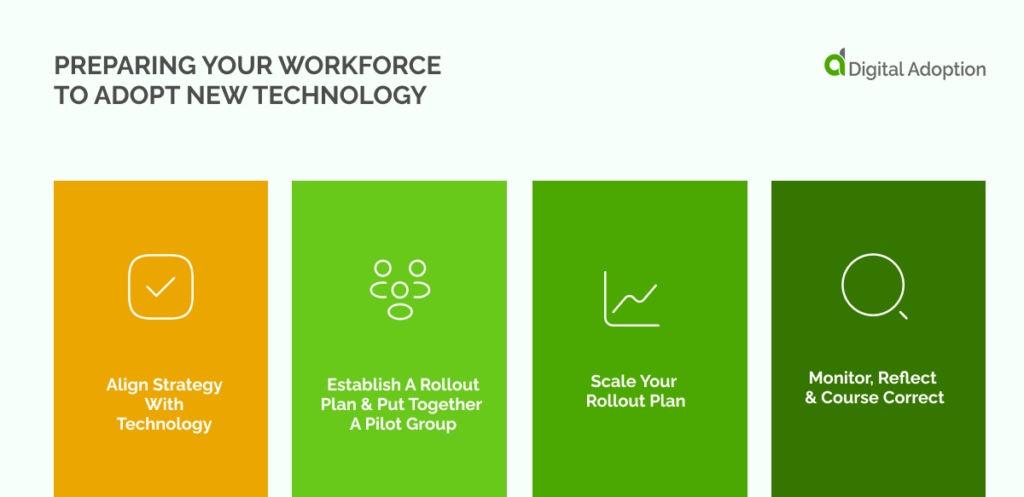
Digital technology is one of the most significant tools determining a company’s success. But many businesses are struggling to motivate their workforce to adapt. Digital leaders focus on the future. They stay ahead of the competition by looking out for new technological trends or areas for digital innovation.
Hyper-vigilance is essential, but it means more pressure on employees to adapt to new technology. An unprepared workforce will stall the digital transformation process. It’s important to address these issues in the planning stage to avoid disruptions.
So, how can you encourage your employees to embrace digital transformation?
Align Strategy With Technology
Employees reject new technology when they don’t see how it fits into a larger strategy. Technology investments should align with company goals to grow the business. Communicate the intentions of your digital transformation plan. Explain how new software will contribute to the success of your strategy.
It’s also important to consistently communicate the major benefits of digital adoption. Show the ways that new systems can revolutionize workflow. Digital tools lead to more convenience, efficiency, and greater opportunities for collaboration.
You must communicate these perks to stakeholders too. Stakeholders are key decision-makers responsible for the buy-in on new tech investments.
Establish A Rollout Plan & Put Together A Pilot Group
After bringing on board key stakeholders, you can begin organizing a pilot group. Consider who new technology will impact the most. You’ll use the pilot group to collect information on the inclusion of a new digital solution. Think of it as a test run before embarking on a wider-scale rollout.
The pilot group should reflect a range of users throughout the company. Comprehensive data collection means better insights for crafting an extensive rollout plan. For example, administrators and managers use digital solutions for different purposes than most staff. They also have different levels of confidence in using new tech.
It can be hard to track such a wide range but remember that your digital transformation strategy needs to be inclusive. The only way to achieve this is through customized training. This segmented approach makes all the difference when introducing technology on a large scale.
Scale Your Rollout Plan
Once you feel confident that you’ve gained all the insight you can from your pilot group, you can begin to scale your rollout plan. Transition slowly from old systems to new ones, allowing time for experimentation.
Some employees may try to stick to old work processes, which will only slow down everyone else. Try to address areas of resistance early and reward those who adopt new tools.
It’s crucial to offer support during the learning process. Create a space for communication between management and users. Encourage and act on employee feedback to address weak areas of the adoption process.
Monitor, Reflect & Course Correct
Remember, your digital transformation strategy often doesn’t have an end-point. Yes, it’s important to establish and recognize the achievement of milestones. But don’t make the mistake of stepping back because employees seem to be adapting well.
You should continuously support your employees during a change initiative. If you don’t, you risk them resorting back to using old systems and stalling business operations. A great way to ease employee resistance is through accessible training. Training materials should be available on-demand. Users should have the option to revisit them whenever they need to.
Gartner details a strategy for course correction involving pausing, evaluating, and teaching. They recommend pausing at key moments of the process to analyze the effect of digitalization within the workplace. ‘Evaluate the systems and technology that are in place to assess whether they support desired behaviors or discourage outdated ones.’
Always look for ways to integrate a new digital transformation initiative. If there’s a process that needs improving, chances are there’s a digital solution out there. Remember, you need everyone on board with an organization’s digital transformation to ensure success.
Planning & Preparing For Digital Change
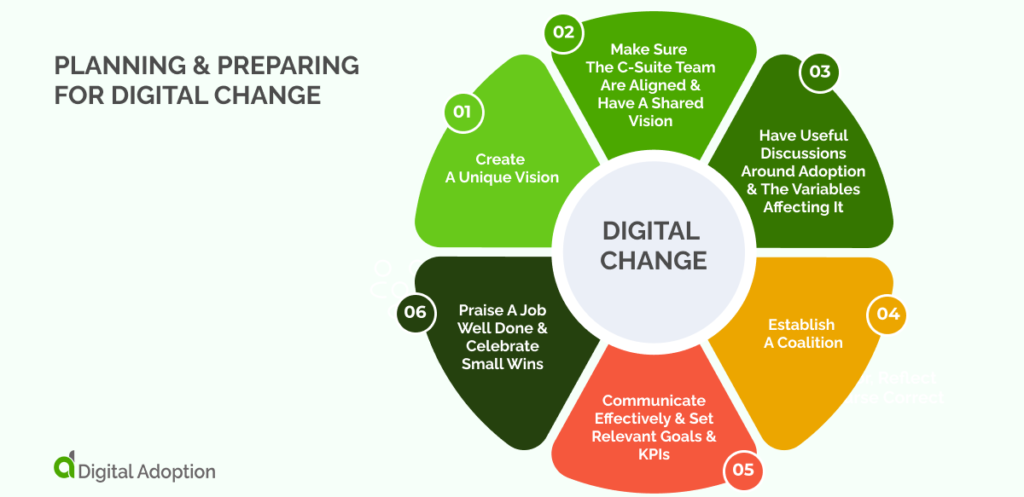
Technology has the potential to transform a business, but getting the most out of digital technology isn’t easy. We’ve established that a crucial stage of a digital transformation strategy is addressing resistance in the workforce. But how else can you prepare for digital change?
Create A Unique Vision
The foundation of any successful plan is a unique vision. Establish company goals you aim to achieve through a digital transformation strategy.
Will your company be entering a new domain? Are you planning to overhaul your current business model? Will you use digital technology to offer brand-new services to customers? Your business goals should be ambitious and clearly expressed to stakeholders and employees.
Make Sure The C-Suite Team Are Aligned & Have A Shared Vision
The best way to influence organizational change is by leading by example. Executive-level decision-makers should have unified ambitions. This will be one of the first steps of your digital adoption plan. Before rolling out technology solutions, you need the full support of the C-suite team.
Not only will this encourage a ripple effect of enthusiasm throughout the company, but it will impact change management strategies. Senior management can manage digital adoption within their teams if they receive support from the top.
Have Useful Discussions Around Adoption & The Variables Affecting It
Be transparent with your planning to ensure everyone is on the same page. Employees and stakeholders not only need to understand the benefits of digital adoption, but they also need to know the challenges. Have valuable discussions around the variables of digital innovation.
For example, how compatible is your business with new digital solutions? Will one system be easier to integrate than another? Discuss the possibility of experimentation with each new technology. And communicate how you aim to observe the adoption process. You need to consider all these variables in advance to minimize disruptions.
Establish A Coalition
A major obstacle to achieving digital adoption is engaging individual users. A solution is to encourage social influence within an organization. You can do this by establishing a coalition.
A coalition is a small group of employees representing the early adopters of new technology. This group embodies the desired attitudes of employees during digital adoption. They can lead by example, demonstrating the practical benefits of digital solutions.
Employees are more likely to adapt if group members trial the process. The average person is unlikely to take the first step toward change. Creating a coalition pushes the rest of the company to adopt quicker.
Communicate Effectively & Set Relevant Goals & KPIs
Communication needs to be a two-way system. Create room for user feedback during the process. Let employees know that their opinion matters. Remember, transparency is crucial to streamlining digital adoption.
Employees need to see how the company’s digital adoption goals are relevant to their work. How will digital transformation make their lives easier? The clearer you make this, the better. Employees can then feel enthusiastic about helping the business achieve its goals.
To measure progress, establish relevant Key Performance Indicators (KPI). One of the most useful KPIs is user satisfaction. Higher user satisfaction leads to successful digital adoption. Measuring satisfaction levels with new software is a great way to tell if you’re meeting business objectives.
Praise A Job Well Done & Celebrate Small Wins
Digital transformation can be daunting to employees who prefer doing things the old way. Recognizing hard work during digital transformation is essential to avoid learning fatigue.
Business leaders tend to focus on the big picture. A positive return on technology investments is important, but employees don’t often see that side of the business. Instead, employees focus on small wins, like passing a stage of training or becoming competent using a new digital tool. Remember to celebrate these small victories with employees, so they don’t get discouraged.
How To Form The Right Digital Adoption Strategy For Your Business
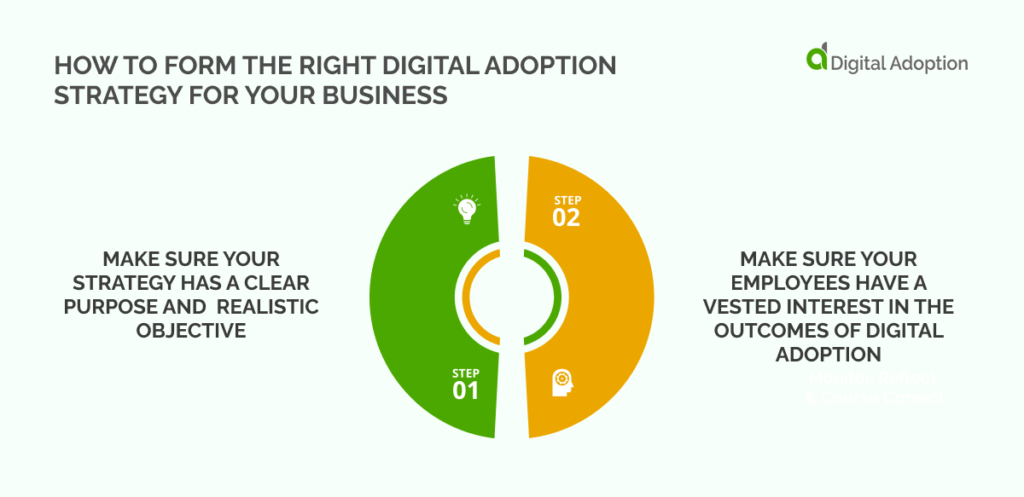
Every business will approach its digital transformation strategy differently depending on its needs. To form the right strategy for your business, you must ask important questions about the organization’s future. What is the vision for your company, and how will digital transformation move your business closer to that vision?
Make Sure Your Strategy Has A Clear Purpose and Realistic Objectives
Digital technology can completely restructure an organization. Digital solutions create avenues for new business models and domains. The internet, for example, created new ways for businesses to reach customers. They could offer new online-only services through global connectivity.
It’s within your grasp to harness the transformational potential of digital technology. But your strategy must have a clear purpose. Implementing new technology to grow your business is a vague goal. It doesn’t inspire company-wide change. Outline realistic objectives and explore how digital assets can help you achieve them.
Make Sure Your Employees Have A Vested Interest In The Outcomes Of Digital Adoption
Once you establish your digital transformation strategy’s desired outcomes, ensure you communicate them to employees. More importantly, make sure employees understand how they will benefit. Ask yourself, why should my employees care about digital adoption?
The answer may seem obvious, but employees must share the company’s ambitions. Show them the perks of successful digital transformation: increased productivity, improved daily workflow, and more opportunities for individual growth within the company.
The Vision of Digital Maturity – Planning for The Future

Digital maturity measures an organization’s ability to derive value from digital technology. Digital maturity will determine the success of your transformation efforts. Using the four-step planning method outlined in this article, you’ll have a much better chance of achieving digital maturity.
Remember, an effective plan involves a holistic approach to adoption. This means tackling all areas of your business at once. It’s useful to experiment with digital transformation, and of course, not everyone adapts at the same speed. But neglecting entire departments within an organization can stall the whole process.
It’s tempting to slow down or give up during digital transformation. To avoid discouragement, refer to your vision. Creating a vision for the future of your digital-first company gives you the boost to push ahead. This vision should be compelling and communicated to stakeholders and employees alike.
As the digital revolution takes us to new and unfamiliar terrain, it’s crucial to be open to change. Companies fail in their digital transformation strategies when they fall behind their competition.
The only way to maintain momentum is to create a company that embraces digital transformation. And the only way to achieve this is through a carefully planned and comprehensive digital adoption strategy. We hope this guide sets you on your way to digital maturity and future success.

